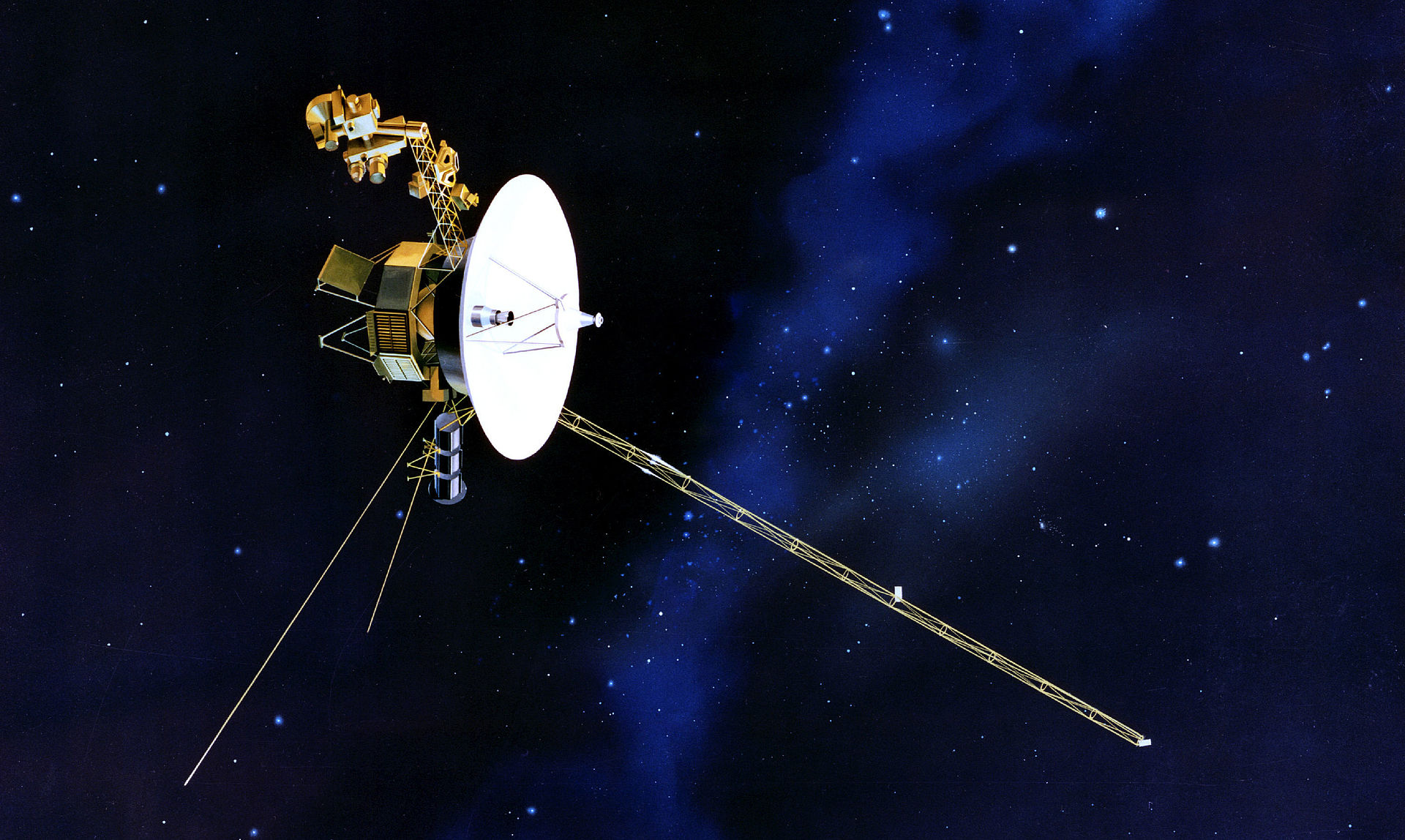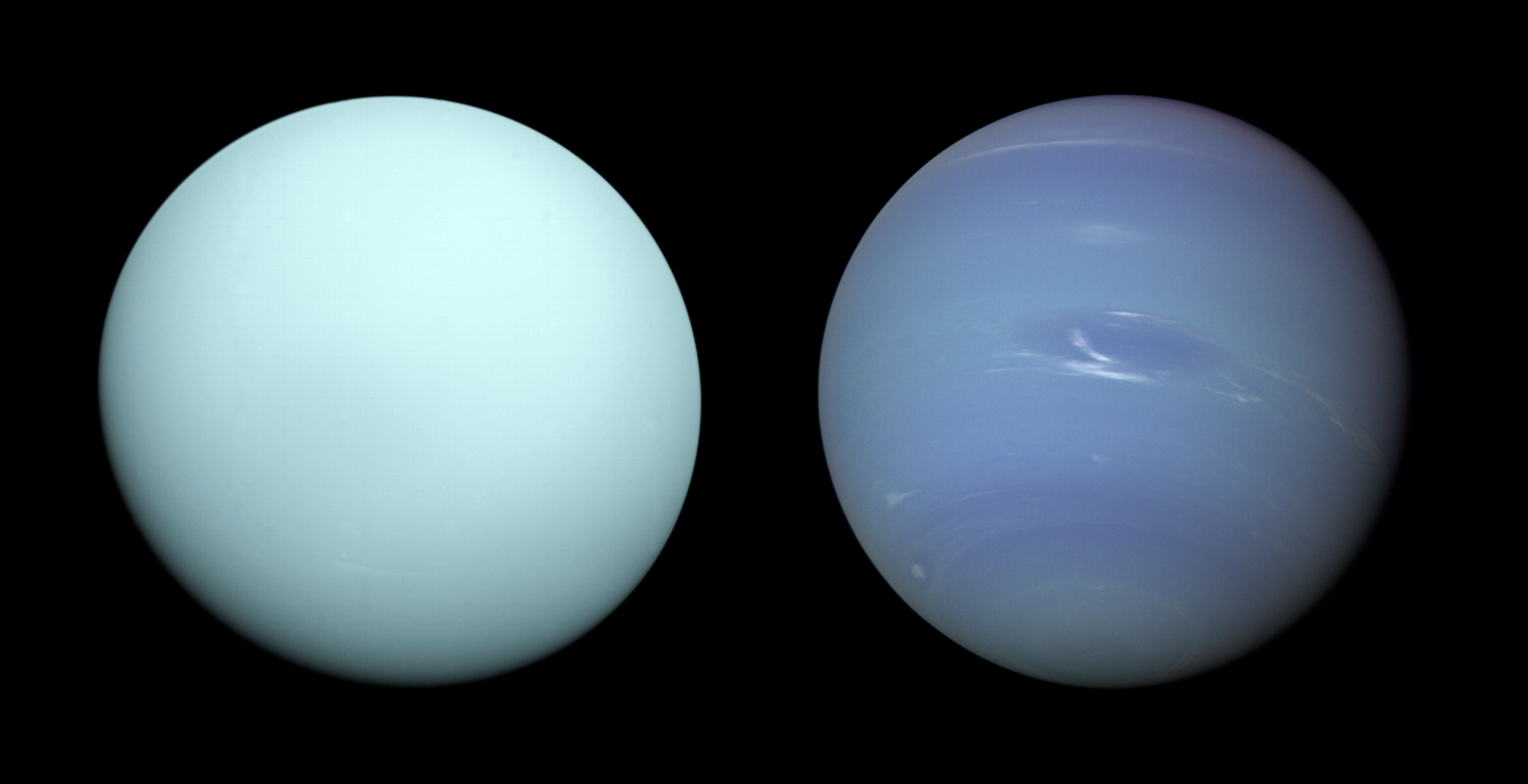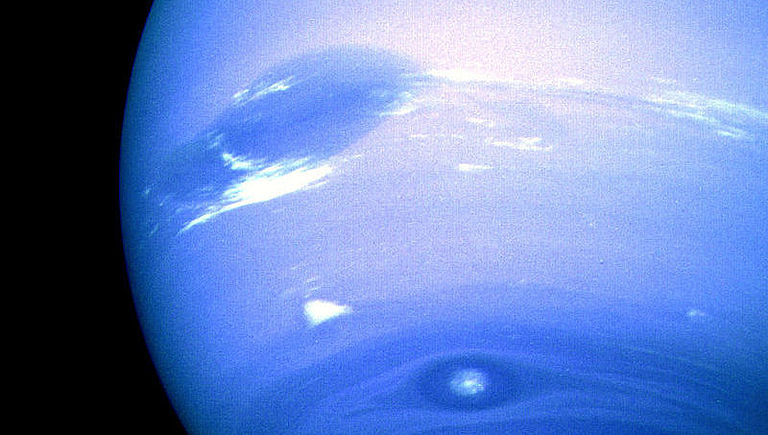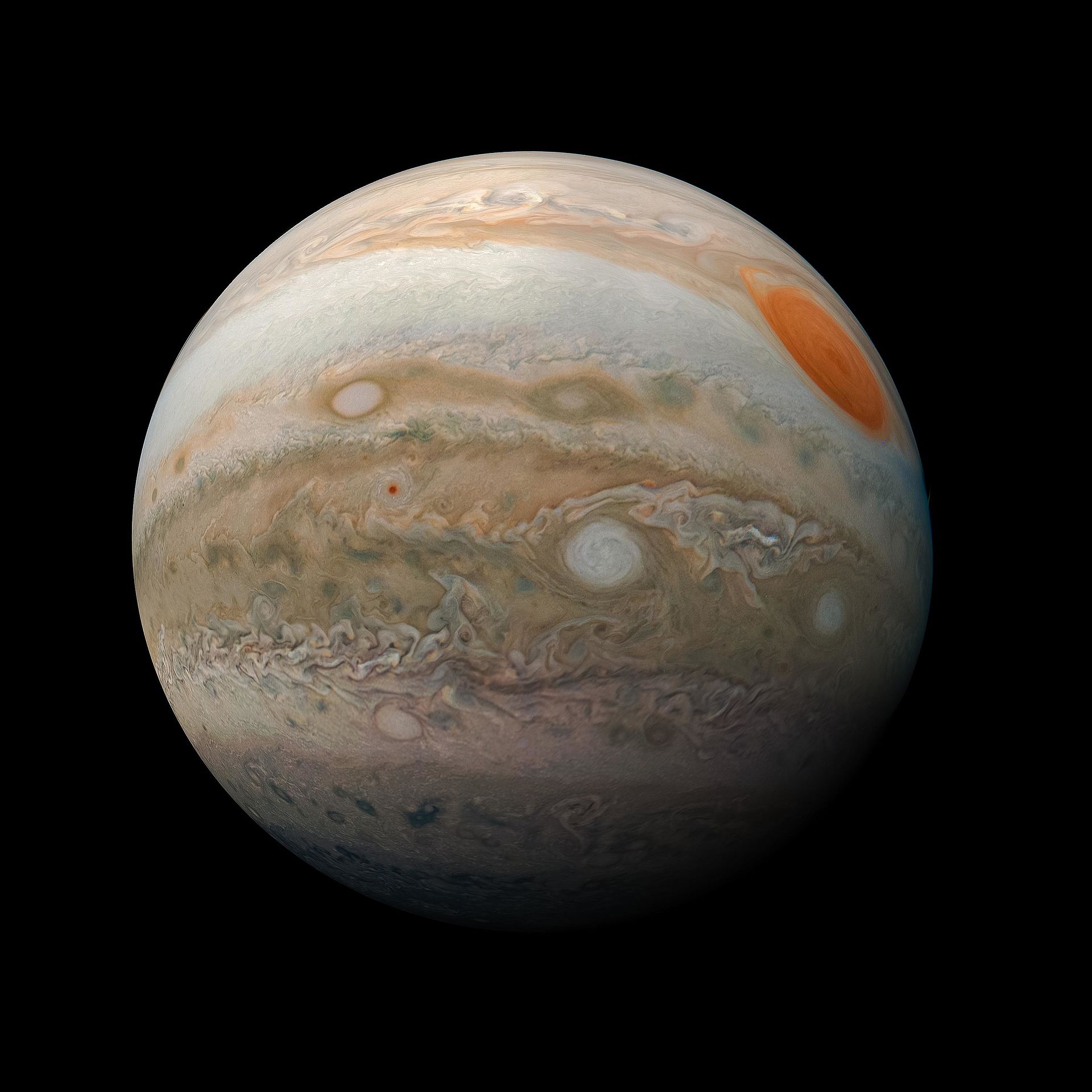On our journey through the solar system, we have long since left the terrestrial planets behind us and have recently taken a closer look at the gas giants Jupiter and Saturn. Since Pluto ceased to be a planet in 2006, only two planets remain that we have not yet seen: the ice giants Uranus and Neptune. Due to their great distance from the Earth, Uranus and Neptune have not had many visitors so far. Only the NASA probe Voyager 2 could fill its Instagram profile with images of the two ice giants. But aren't there rumours that it rains diamonds on Uranus and Neptune? And where does the blue colour of the two planets come from?
Uranus: The slow wanderer
With a diameter of a good 51,000 kilometres, Uranus is the third largest planet in our solar system after Jupiter and Saturn. The planet was discovered in 1781 by the German-British astronomer and musician Friedrich Wilhelm Herschel. Before that, Saturn was considered to be the outermost planet. One of the reasons for this is that Uranus is always at least 2.5 billion kilometres away from the Earth and therefore difficult to see with the naked eye. Moreover, unlike the other planets, it moves very slowly across the night sky. Uranus takes two hours to cover its own diameter and 84 years to orbit the sun. By comparison, it takes the Earth only about seven minutes to cover its own diameter.
For this reason, the British astronomer John Flamsteed, who observed Uranus as early as 1690, wrongly mistook it for a star in the constellation of Taurus and catalogued it accordingly as "34 Tauri". Friedrich Wilhelm Herschel initially also thought that the bluish-green disc, which he discovered by chance during a routine sky survey, was a comet. Only after longer observation did it become clear that this assumption was a misjudgement and that the newly discovered celestial body was in fact a seventh planet.
A system for naming stars that is still widely used today dates from the seventeenth century and was devised by the German astronomer Johann Bayer. According to his system, each star's name consists of a Greek letter followed by the genitive of the Latin name of the constellation in which the star lies. Which letter the star receives depends on its brightness. Alpha Centauri is therefore the brightest star in the constellation Centaurus.
A similar system was developed by the British astronomer John Flamsteed, but he used numbers instead of Greek letters and ordered the stars not according to their brightness, but according to their right ascension. Simply put, the right ascension is a measure of how far west or east an object is in the sky.
Difficult name finding
The search for a name for the new planet initiated a debate that lasted for more than sixty years. Herschel himself named his discovery "Georgium Sidus" - George's star - in honour of the English King George III. However, this name was unacceptable to astronomers in France, which during that time was at loggerheads with England, so the name "Herschel" was used instead. It was not until 1850 that Uranus was given its present name: On a suggestion of the German astronomer Johann Elert Bode the planet was named after the Greek celestial god Ouranos. Unlike the other planets in the solar system, Uranus does not have a name that is directly derived from Roman mythology. The Roman equivalent of Ouranos would be Coelus, the current spelling of the name is merely a Latinisation of the Greek name.
A planet that lies on its side
A peculiarity of Uranus is its axis of rotation, which is inclined by 97.77 degrees to the perpendicular of the orbital plane. This means that the planet lies on its side and "rolls" around the sun in an almost circular orbit. Uranus completes a complete rotation around itself in just over seventeen hours. Due to this fast rotation and its low density the planet is flattened at the poles.
Blue planet
When we speak of the "blue planet", we usually mean the Earth, although Uranus would also be a suitable candidate to bear this epithet. Unlike the Earth, however, its colouring is not produced by water oceans on the surface, but by methane gas in the high atmosphere. This gas absorbs the red part of the sunlight reflected by the uppermost cloud layers, but allows the blue part to pass through, so that the entire planet appears uniformly greenish-blue.
As with Jupiter and Saturn, the atmosphere of Uranus is not clearly limited towards the bottom. Since the pressure in the depths of the atmosphere exceeds the critical point, the gaseous envelope changes from a gaseous to a liquid state without phase transition.
Whether Uranus has a solid core has not yet been conclusively clarified. Beneath its gaseous envelope, the planet consists of a layer of atmospheric constituents that have become liquid as a result of the high pressure. Beneath that is a somewhat thicker layer of water, methane and ammonia. This hot, supercritical fluid probably has the consistency of ice and encloses the planet's core. The core is believed to consist of silicon and iron and is possibly also liquid. Its mass is approximately equal to the mass of the Earth. It is assumed that there is a pressure of more than eight million bar in the centre of the planet's core and that the temperature is about 5,000 degrees Celsius.
What is ice? The most obvious answer would be: water in a frozen state. In astrophysics and planetary research, however, the term is used not only for water but also for all other volatile chemical compounds whose freezing points are above 100 Kelvin (-173 °C). Examples of such compounds include ammonia and methane.
Calm weather
Storms occur in the atmosphere of Uranus, some of which last for months. However, weather phenomena on Uranus are not nearly as spectacular as on Jupiter. This is partly due to the great distance of the planet from the sun.
A magnetic field with four poles
For navigation in the magnetic field of Uranus a terrestrial compass is not very helpful. The reason for this is that the magnetic field is not a dipole as on Earth, but a quadrupole with two north and two south poles. One pair of poles corresponds roughly to the north and south poles of the Earth, while the axis of the second pair of poles is inclined at 60 degrees to the axis of rotation and does not pass through the centre of the planet. This unusual geometry results in a highly asymmetric magnetosphere in which the magnetic field strengths can differ by more than one order of magnitude.
Light moons and dark rings
To date, 27 Uranus moons are known, with diameters ranging from 10 to 1,600 kilometres, of which only the five main moons Miranda, Ariel, Umbriel, Titania and Oberon have a mass large enough to assume the shape of a rotational ellipsoid. Uranus thus has the least massive satellite system of all the giant planets.
Like all other giant planets in the solar system, Uranus is also surrounded by a ring system. This consists of both coarse lumps with a diameter of up to 10 metres and very fine dust. Most of the rings lie in the equatorial plane of the planet. Due to the almost right-angled inclination of the axis of rotation, the rings orbit the planet like Ferris wheels.
Exploration of Uranus
So far Uranus has only been visited by a single space probe: Voyager 2. The probe was launched on August 20, 1977 and reached Uranus in 1986. Most of the images and data known today come from this mission. Two previously unknown rings and ten new moons were discovered during the approach of the probe. An eleventh new moon was identified thirteen years later on the images taken by the probe and its existence was confirmed by the Hubble Space Telescope after another four years.
No further missions to Uranus are currently planned. This is primarily due to the enormous distance that has to be covered. In the years 2030 to 2034 a favourable time window opens up for a launch towards Uranus - but the travel time would still be at least eleven years.

Neptune: The invisible planet
Neptune is the eighth and outermost planet in our solar system and the only planet that is never visible to the naked eye from Earth. Unlike the other planets, the discovery of Neptune is not based solely on observations of the night sky. A first indication of its existence were disturbances in the orbit of Uranus, which suggested the presence of an eighth planet. Based on these orbital disturbances, the French astronomer Urbain Jean Joseph Le Verrier calculated the position of the hypothetical eighth planet in 1846 and sent his results to the Berlin observatory. The fact that the calculations were correct and that an eighth planet actually existed was confirmed shortly after the results were received: Johann Gottfried Galle and Heinrich Louis d'Arrest did indeed discover a celestial body which had not previously been recorded on the star charts at the position indicated by Le Verrier.
Another name dispute
As with Uranus, the naming of the new planet turned out to be not so easy. At times Janus and Oceanus were discussed, from France came the proposal to name the planet after Le Verrier, which was vehemently rejected abroad. Le Verrier himself proposed to name the new planet after Neptunus, the Roman god of the sea. This name was in accordance with the mythological names of the other planets and was accepted internationally shortly afterwards.
A second Uranus?
In many of its characteristics, Neptune is similar to Uranus. With a diameter of almost 50,000 kilometres, Neptune is similar in size to Uranus and is the fourth largest planet in the solar system after the latter. The distance to the Earth is always at least 4.3 billion kilometres and for one orbit around the sun the planet needs about 165 years.
Unlike Uranus, however, Neptune has an axis of rotation that is only slightly inclined. The deviation from the plane of its orbit is 28.32 degrees, which corresponds approximately to the inclination of the Earth's axis of 23.5 degrees. Since Neptune rotates at a similar speed to Uranus - it completes a rotation around itself in just under 16 hours - it also has a flattened shape at the poles.
The bluest planet
The atmospheres of Uranus and Neptune have a similar composition. The main components of both are hydrogen and helium. Like the high atmosphere of Uranus, the upper layers of the Neptune atmosphere also contain methane gas. This and another as yet unidentified atmospheric constituent give Neptune its intense deep blue colour.
The internal structure of Uranus and Neptune is also very similar. In Neptune's atmosphere the pressure also rises with increasing depth above the critical point, so that no clear surface can be defined. It is assumed that Neptune has a solid core of rock and metal of similar size and mass to Earth. This core is surrounded by a mantle of rock, water, ammonia and methane. Although it is a hot and very dense liquid, this mixture is called ice, as in Uranus, because of its composition.
Changing atmosphere
While the weather on Uranus can be described as rather calm, Neptune's atmosphere is in constant change. Although the planet is very far away from the sun, Neptune experiences storms with extremely high wind speeds. Peak values of up to 2,100 kilometres per hour have been measured. What drives these violent storms has not yet been conclusively clarified.
Complex magnetic field
Like Uranus, Neptune has a highly asymmetrical and inhomogeneous magnetic field with two north and two south poles, the origin of which is still a mystery to science.
Tenuous rings and sea deities as moons
Neptune is surrounded by a fine ring system which, like the rings of Uranus and Jupiter, reflects very little light and consists to a large extent of microscopic dust grains. Although the first signs of the existence of a ring system were already found in the early 1980s during observations of star occultations, its structure, like that of Uranus, could only be captured in images for the first time during the flyby of the Voyager 2 probe in 1989.
So far, fourteen Neptune moons are known. By far the largest moon is Triton, which is the only large moon in the solar system to have a retrograde orbit, i.e. it orbits Neptune against the direction of rotation. It was observed for the first time seventeen days after the discovery of Neptune and is approaching the planet in a spiral orbit. With a surface temperature of -235 degrees Celsius, Triton is the coldest object in the solar system that has ever been studied.
The second Neptune moon, Nereid, was discovered more than 100 years after Triton. Like Triton and also all later discovered moons of Neptune, Nereid is named after a minor sea deity subordinated to Neptunus.
All other moons were discovered between 1989 and 2013. Six of them were also found by Voyager 2, while the remaining moons were tracked down from Earth or from Earth orbit with the Hubble Space Telescope.
Neptune probes
Like Uranus, Neptune has so far only been visited by the space probe Voyager 2.
And what about the hail of diamonds?
The hypothesis of hail of diamonds on the ice giants has been around for quite some time. The basis for this assumption is the fact that the hot, dense liquid surrounding the planetary cores of the ice giants contains the hydrocarbon methane and is exposed to extremely high pressures. Under the conditions prevailing in the interior of Uranus and Neptune, the methane can decompose into its constituent parts, and it is assumed that the extreme pressure combined with the high temperatures will cause the carbon atoms to recombine in a cubic arrangement, thereby forming diamonds which then slowly sink into the planet's core.
In 2017 this process could be reproduced in the laboratory for the first time. To simulate the atmospheric composition of the ice giants, the scientists used the plastic polystyrene, which is also composed of carbon and hydrogen. The scientists sent two shock waves generated by lasers through the polystyrene, which compressed the plastic at a temperature of 5,000 degrees Celsius. This actually produced tiny diamonds. While sounding quite ridiculous, the story of the diamond hail is therefore actually plausible.




